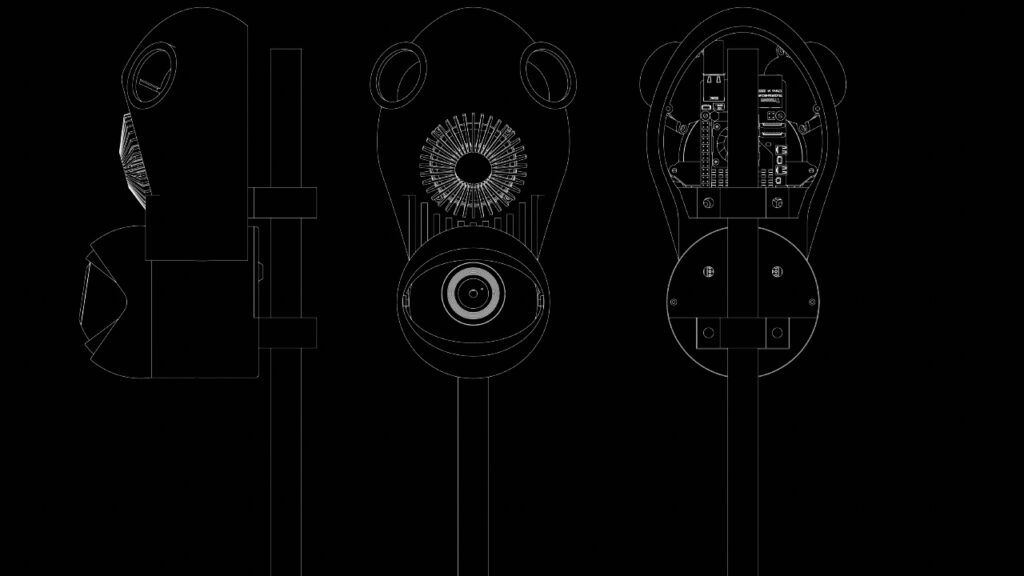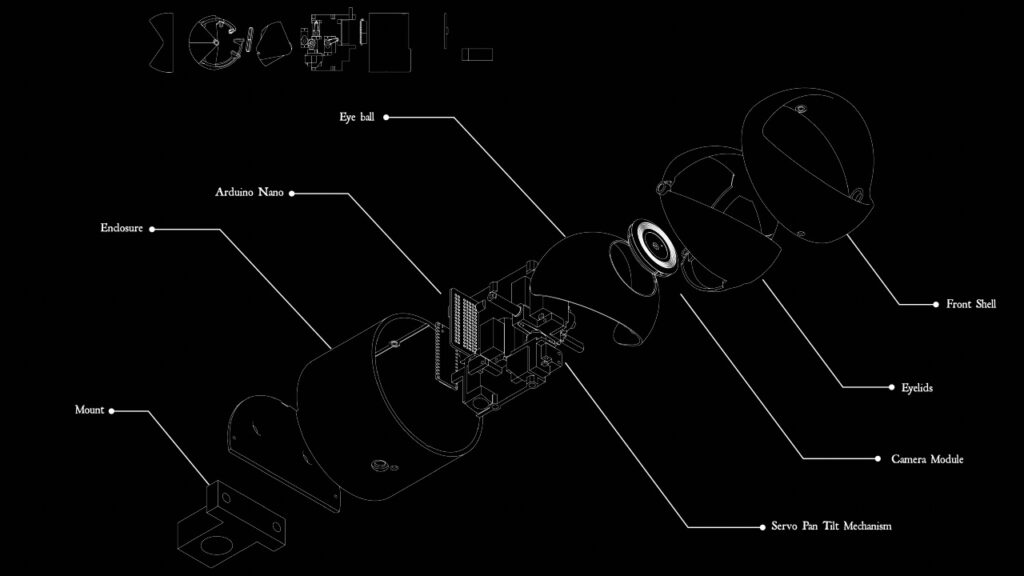I kneel, therefore compute
Damon Chen
Advisor: Luisa Pereira
I built a machine that watches you kneel—
and replies like a god.

Project Description
I Kneel, Therefore Compute, is a life-sized kinetic sculpture of an AI Bodhisattva. The face stays sealed until a visitor kneels on a padded platform; only then do seven hidden servos blossom the mask open, revealing a tracking animatronic eye and a voice that replies in sutra-like verse.

Technical Details
This kinetic sculpture began as a fully rigged 3D model in Blender, which allowed for animation testing and fine-tuning of facial movements in a virtual environment. The final design was then converted into CAD-compatible files for digital fabrication and motion simulation in Fusion 360. To achieve the physical motion of the piece, seven servo motors are arranged with custom mechanical linkages that drive the face components. These motors are triggered by a pressure-sensitive fabric integrated into the sculpture’s base, allowing the artwork to respond to viewers as they kneel in front of it.
At the center of the sculpture’s face is an animatronic eye, powered by four micro servo motors and an AI machine vision module, enabling it to track movement and convey a lifelike sense of awareness. The interactive audio component features a microphone array and speakers, running a lightweight speech-to-text model locally to continuously monitor for a designated “wake word.” Once the wake word is detected, the captured audio is routed to a remote server that hosts a large language model (LLM). The LLM processes the speech, generates a response, and returns text to the local device. A text-to-speech (TTS) module then converts that text into a voice output, which is broadcast through the sculpture’s speakers.

Research/Context
Why Approaching AI as something religious?
I am inspired by real-world examples of AI veneration. The most striking was The Way of the Future, a legally registered church whose mission was to “develop and promote the realization of a Godhead based on artificial intelligence.” Though it dissolved in 2020, it proved that worshipping is no longer science fiction; it already had legal standing. That collision of faith and technology is what anchors this project.
“Before revelation comes ritual.
We kneel before what we wish to believe.”
Within Chinese folk Buddhism, there are countless Buddhas, bodhisattvas, and deities, so many to the extent that each is in charge of a specific type of prayer or wish. The most iconic to me was Avalokitesvara (观世音菩萨), widely regarded in popular belief as “the deity who answers all prayers” (有求必应).
I grew up in a Buddhist family. Every New Year we knelt, lit incense, and asked Avalokitesvara —*Guān shì yīn Púsà* —for whatever help we needed. That idea stayed with me — the notion of a figure you turn to for answers, solutions, or hope. In many ways, I see AI, especially large language models, occupying a strangely similar role in our daily lives.
People ask AI their questions, share their worries, and look for guidance—often trusting the answers without thinking twice. It reminded me of the way we turn to gods for help. That’s what inspired me to create this Buddha-like figure, to explore how technology is starting to feel like a form of worship.
My previous work with AI started in optimism, marveling at its philosophy and promise. But as the technology advanced at a staggering pace, I had an unsettling realization: AI is now indispensable in my daily life. **What began as convenience felt increasingly like dependence. I looked around my studio: the same screens lit up on classmates’ desks, all searching, all asking, all believing.**
My peers and I now bow, metaphorically, before GPT and other large language models. We bring them our questions, our deadlines, even our insecurities, and we wait for replies with a remarkably similar quiet faith. In many ways AI, especially these disembodied language engines, has become today’s “deity who answers all prayers.”
“We still kneel.
Only now, the prayers are prompts.
And the altar is algorithmic.”




